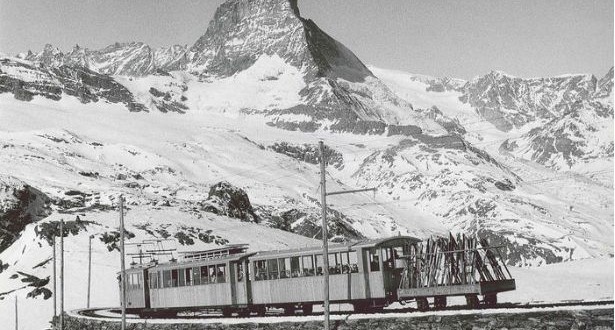The GGB Gornergrat Bahn started operation on August 20th 1898 which was the first electric rack railway in Switzerland and the second in the world. A tourist attraction of the Extra class was created thanks to innovation pioneering spirit and the Gornergrat Bahn was the first railway in Europe to run at an altitude of more than 3000 meters above sea level. The mysterious world of the mountains was made accessible to everyman by the Gornergrat Bahn and even in winter from 1928 onwards. In this way, an important foundation was laid for winter tourism, which was rapidly gaining in importance.
The perilous, wild and mysterious world of the Alps has attracted more and more people since the 18th century. Guests from all around the world have wanted to be close to the majestic snow covered mountains, to discover the wonder of nature and to conquer the summits. One summit in particular was especially fascinating for the early adventurers, the 4478 meter high Matterhorn. The first ascent was a sensation at the time. The interest of the first alpinists for the Gornergrat was similarly high, after all, you can see 29 four thousand meter mountains from this point. The Gornergrat Panorama first appeared in the travel guide “Baedeker” in 1856, and the Gornergrat has been marked on the Swiss Dufour map since 1862, with actual tourism on the Gornergrat developing from around 1870. As early as 1890, even before the completion of the railway to Zermatt, around 8000 guests had already visited the Gornergrat.
There was great opposition to the construction of the Gornergrat Bahn at the beginning, above all due to the competition that the railway threatened to provide the guides and porters. In its letter, the Federal Council countered the fears of the local people by pointing out that the same fears had been proved to be groundless in the Bernese Oberland. The construction of the gigantic excursion railway, the GGB Gornergrat Bahn, started in 1896. As the Gornergrat is at an altitude of 3089 meters, the available construction period between the melting of the snow and the onset of the following winter was extremely short. More than 1000 workmen were used at the same time, most of them Italians. In total, around 2400 workers were employed during the two year construction phase.
The Federal Council was proved to be right. The news of alpine conquests and the opening up of the route from Visp to Zermatt in the year 1891 by the Vist-Zermatt-Bahn had made Zermatt world famous even then. The new attraction, the first electric rack railway in Switzerland and the second in the world, greatly increased the attraction of the young alpine tourist resort of Zermatt from 1898 onwards. Thanks to the start of winter operations by the then BVZ company and the Gornergrat Bahn in the year 1928, winter tourism could be developed in Zermatt, and prosperity increased rapidly in the Matterhorn village. The fears of the negative effects of the Gornergrat Bahn was soon forgotten, and more than one hundred years later, the Gornergrat Bahn is still a jewel in the tourism crown of Zermatt. Even today, it is still the highest altitude, open air rack railway in Europe. The fascination of making your way comfortably into the alpine mountains by train is unbroken.

